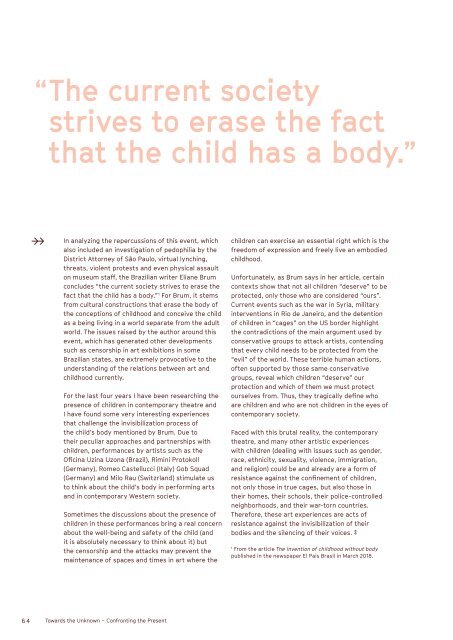ASSITEJ Magazine 2019
This is the annual ASSITEJ magazine, launched during the ASSITEJ Artistic Gathering 2019 in Kristiansand (Norway). It contains high-quality articles on theatre for young audiences from all corners of the world!
This is the annual ASSITEJ magazine, launched during the ASSITEJ Artistic Gathering 2019 in Kristiansand (Norway). It contains high-quality articles on theatre for young audiences from all corners of the world!
Create successful ePaper yourself
Turn your PDF publications into a flip-book with our unique Google optimized e-Paper software.
“The current society<br />
strives to erase the fact<br />
that the child has a body.”<br />
In analyzing the repercussions of this event, which<br />
also included an investigation of pedophilia by the<br />
District Attorney of São Paulo, virtual lynching,<br />
threats, violent protests and even physical assault<br />
on museum staff, the Brazilian writer Eliane Brum<br />
concludes “the current society strives to erase the<br />
fact that the child has a body.” 1 For Brum, it stems<br />
from cultural constructions that erase the body of<br />
the conceptions of childhood and conceive the child<br />
as a being living in a world separate from the adult<br />
world. The issues raised by the author around this<br />
event, which has generated other developments<br />
such as censorship in art exhibitions in some<br />
Brazilian states, are extremely provocative to the<br />
understanding of the relations between art and<br />
childhood currently.<br />
For the last four years I have been researching the<br />
presence of children in contemporary theatre and<br />
I have found some very interesting experiences<br />
that challenge the invisibilization process of<br />
the child’s body mentioned by Brum. Due to<br />
their peculiar approaches and partnerships with<br />
children, performances by artists such as the<br />
Oficina Uzina Uzona (Brazil), Rimini Protokoll<br />
(Germany), Romeo Castellucci (Italy) Gob Squad<br />
(Germany) and Milo Rau (Switzrland) stimulate us<br />
to think about the child’s body in performing arts<br />
and in contemporary Western society.<br />
Sometimes the discussions about the presence of<br />
children in these performances bring a real concern<br />
about the well-being and safety of the child (and<br />
it is absolutely necessary to think about it) but<br />
the censorship and the attacks may prevent the<br />
maintenance of spaces and times in art where the<br />
children can exercise an essential right which is the<br />
freedom of expression and freely live an embodied<br />
childhood.<br />
Unfortunately, as Brum says in her article, certain<br />
contexts show that not all children “deserve” to be<br />
protected, only those who are considered “ours”.<br />
Current events such as the war in Syria, military<br />
interventions in Rio de Janeiro, and the detention<br />
of children in “cages” on the US border highlight<br />
the contradictions of the main argument used by<br />
conservative groups to attack artists, contending<br />
that every child needs to be protected from the<br />
“evil” of the world. These terrible human actions,<br />
often supported by those same conservative<br />
groups, reveal which children “deserve” our<br />
protection and which of them we must protect<br />
ourselves from. Thus, they tragically define who<br />
are children and who are not children in the eyes of<br />
contemporary society.<br />
Faced with this brutal reality, the contemporary<br />
theatre, and many other artistic experiences<br />
with children (dealing with issues such as gender,<br />
race, ethnicity, sexuality, violence, immigration,<br />
and religion) could be and already are a form of<br />
resistance against the confinement of children,<br />
not only those in true cages, but also those in<br />
their homes, their schools, their police-controlled<br />
neighborhoods, and their war-torn countries.<br />
Therefore, these art experiences are acts of<br />
resistance against the invisibilization of their<br />
bodies and the silencing of their voices.<br />
1<br />
From the article The invention of childhood without body<br />
published in the newspaper El Pais Brasil in March 2018.<br />
64 Towards the Unknown – Confronting the Present



